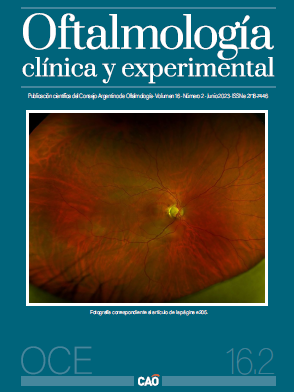Axial length changes with diffusion optics multiple segments (DOMS) spectacles for myopia control
DOI:
https://doi.org/10.70313/2718.7446.v16.n02.228Keywords:
myopia, DOT and DOMS technology spectaclesAbstract
Purpose: To evaluate short time axial length changes after the use of an especially designed spectacle with peripheral contrast reduction.
Methods: A pilot study was performed in subjects were tested when using especial peripheral contrast modulation spectacles with a central zone with the distance myopic correction. During the experiment subjects read a book with black letters on white background on a desktop computer with the same brightness in two periods, one with usual spectacles and the second with the especial ones. Before and after these periods, 10 measurements of the axial length of the right eye were made with Lenstar 900 biometer and were averaged up to three decimals.
Results: Eight subjects, whose a mean age was 22.3 ± 5.5 years participated in this study. The mean spherical equivalent of their right eye was -2.31 ± 1.06 diopters. There was a significant difference of +16.1 microns increased axial length from baseline when reading with the usual prescription during the first 40 min period. When subjects read in the same situation with the contrast modulation spectacle, the axial length change significantly reversed, shortening by -9.2 microns (p<0.001 and p=0.002, respectively Student’s t test).
Conclusion: The decrease in axial length with the tested spectacles may be due to choroidal thickening. As myopia development is arrested when choroid becomes thicker, these spectacles could be tested for myopia control in a clinical trial.
Downloads
References
Brennan NA, Toubouti YM, Cheng X, Bullimore MA. Efficacy in myopia control. Prog Retin Eye Res 2021; 83: 100923.
Chamberlain P, Lazon de la Jara P, Arumugam B, Bullimore MA. Axial length targets for myopia control. Ophthalmic Physiol Opt 2021; 41: 523-531.
Wallman J, Winawer J. Homeostasis of eye growth and the question of myopia. Neuron 2004; 43: 447-468.
Smith EL 3rd, Hung LF. Huang J. Relative peripheral hyperopic defocus alters central refractive development in infant monkeys. Vision Res 2009; 49: 2386-2392.
Berntsen DA, Barr CD, Mutti DO, Zadnik K. Peripheral defocus and myopia progression in myopic children randomly assigned to wear single vision and progressive addition lenses. Invest Ophthalmol Vis Sci 2013; 54: 5761-5770.
Lin Z, Martinez A, Chen X et al. Peripheral defocus with single-vision spectacle lenses in myopic children. Optom Vis Sci 2010; 87: 4-9.
Backhouse S, Fox S, Ibrahim B, Phillips JR. Peripheral refraction in myopia corrected with spectacles versus contact lenses. Ophthalmic Physiol Opt 2012; 32: 294-303.
Sankaridurg P, Donovan L, Varnas S et al. Spectacle lenses designed to reduce progression of myopia: 12-month results. Optom Vis Sci 2010; 87: 631-641.
Hasebe S, Jun J, Varnas SR. Myopia control with positively aspherized progressive addition lenses: a 2-year, multicenter, randomized, controlled trial. Invest Ophthalmol Vis Sci 2014; 55: 7177-7188.
Smith EL 3rd, Hung LF, Huang J. Relative peripheral hyperopic defocus alters central refractive development in infant monkeys. Vision Res 2009; 49: 2386-2392.
Troilo D, Smith EL 3rd, Nickla DL et al. IMI: report on experimental models of emmetropization and myopia. Invest Ophthalmol Vis Sci 2019; 60: M31-M88.
Berntsen DA, Barr CD, Mutti DO, Zadnik K. Peripheral defocus and myopia progression in myopic children randomly assigned to wear single vision and progressive addition lenses. Invest Ophthalmol Vis Sci 2013; 54: 5761-5770.
Lin Z, Martinez A, Chen X et al. Peripheral defocus with single-vision spectacle lenses in myopic children. Optom Vis Sci 2010; 87: 4-9.
Backhouse S, Fox S, Ibrahim B, Phillips JR. Peripheral refraction in myopia corrected with spectacles versus contact lenses. Ophthalmic Physiol Opt 2012; 32: 294-303.
Kanda H, Oshika T, Hiraoka T et al. Effect of spectacle lenses designed to reduce relative peripheral hyperopia on myopia progression in Japanese children: a 2-year multicenter randomized controlled trial. Jpn J Ophthalmol 2018; 62: 537-543.
Rappon J, Woods J, Jones D, Jones LW. Tolerability of novel myopia control spectacle designs. Invest Ophthalmol Vis Sci 2019; 60: 5845-5845.
Lam CS, Tang WC, Lee PH et al. Myopia control effect of defocus incorporated multiple segments (DIMS) spectacle lens in Chinese children: results of a 3-year follow-up study. Br J Ophthalmol 2022; 106: 1110-1114.
Bao J, Huang Y, Li X et al. Spectacle lenses with aspherical lenslets for myopia control vs single-vision spectacle lenses: a randomized clinical trial. JAMA Ophthalmol 2022; 140: 472-478.
Rappon J, Chung C, Young G et al. Control of myopia using diffusion optics spectacle lenses: 12-month results of a randomised controlled, efficacy and safety study (CYPRESS). Br J Ophthalmol 2022 doi: 10.1136/bjo-2021-321005.
Iribarren R, Szeps A, Kotlik C et al. Short term axial length changes with defocus spectacles for myopia control. In preparation.
Published
Issue
Section
License
Copyright (c) 2023 Consejo Argentino de Oftalmología

This work is licensed under a Creative Commons Attribution-NonCommercial-NoDerivatives 4.0 International License.
Con esta licencia no se permite un uso comercial de la obra original, ni la generación de obras derivadas. Las licencias Creative Commons permiten a los autores compartir y liberar sus obras en forma legal y segura.







